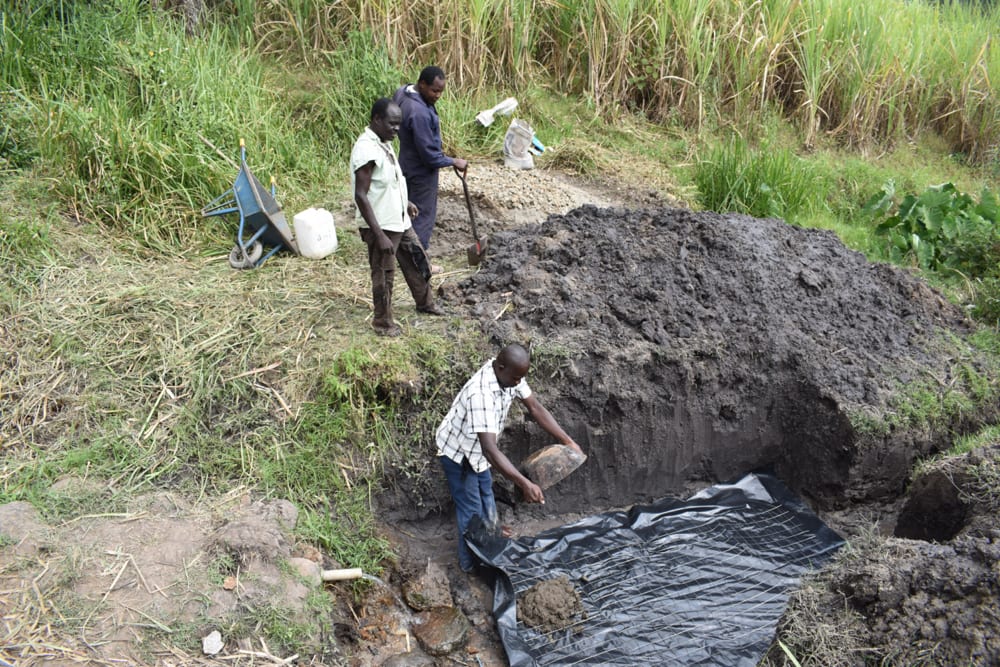Please note: original photos were taken before the COVID-19 pandemic.
"I have been taking this water without any precautions because l didn't have any alternative and it has caused me to spend a lot of money on treatment for waterborne diseases," said 36-year-old Selpha Nyakoa, referring to Ashuma Spring.
Even though Ashuma Spring is the sole source for all of the daily water needs of 210 people in Mabanga, its water is far from safe. The community members face many challenges from this water source, not least of which is that the spring is difficult to access. The community tried to improvise a discharge pipe by sticking a pipe directly into the earth, but the best spot for the pipe was very low down to the ground. When approaching the spring, people must wade through the water and mud to reach the pipe.
Once there, it is very difficult to get the average jerrycan - a 20-liter container - to stand since the pipe is so low. When there are a lot of rains and the pool rises, it is even harder to try to collect water from the pipe without the pool water mixing in. The water is contaminated from surface run-off that carries farm chemicals and animal waste, and any accidental disturbance of the pipe causes dirt and sand to mix with the water.
People often try to wait between water users to reduce the issue of dirt in the water in particular, but with so many people in line, the waiting has to be brief. People waste enough time there as it is, and there are often disputes over who made the water dirty, even though it was unintentional and often unavoidable. Adults have to delay they other work because they are stuck waiting at the spring, and kids can be late to school when their first morning chore is to fetch water for home use.
Community members report that there are worms inside the water that give them rashes and are always making them sick from having to stand in the pool of water at the base of the pipe. Each day they said there is a new case of someone contracting a water-related disease such as typhoid, diarrhea, or rashes on the body, among others. These illnesses caused community members to spend a lot of money on treatment, and some have died from their water-related diseases.
"Using water from this water source has caused me to be absent in school because l have always been sick, coughing and getting rashes on my body. Sometimes I am late to school because of the long queue waiting to fetch water," said primary school student (and son of the spring's landowner) Mike.
The community members have tried to reach out to others before to help them protect their spring, but so far all of their attempts have been in vain, they said. We're excited to change that story forever, starting now.
What We Can Do:
Spring Protection
Protecting the spring will help provide access to cleaner and safer water and reduce the time people have to spend to fetch it. Construction will keep surface runoff and other contaminants out of the water. With the community’s high involvement in the process, there should be a good sense of responsibility and ownership for the new clean water source.
Fetching water is a task predominantly carried out by women and young girls. Protecting the spring and offering training and support will, therefore, help empower the female members of the community by freeing up more of their time and energy to engage and invest in income-generating activities and their education.
Training on Health, Hygiene, COVID-19, and More
To hold trainings during the pandemic, we work closely with both community leaders and the local government to approve small groups to attend training. We ask community leaders to invite a select yet representative group of people to attend training who will then act as ambassadors to the rest of the community to share what they learn. We also communicate our expectations of physical distancing and wearing masks for all who choose to attend.
The training will focus on improved hygiene, health, and sanitation habits in this community. We will also have a dedicated session on COVID-19 symptoms, transmission routes, and prevention best practices.
With the community’s input, we will identify key leverage points where they can alter their practices at the personal, household, and community levels to affect change. This training will help to ensure participants have the knowledge they need about healthy practices and their importance to make the most of their water point as soon as water is flowing.
Our team of facilitators will use a variety of methods to train community members. Some of these methods include participatory hygiene and sanitation transformation, asset-based community development, group discussions, handouts, and demonstrations at the spring.
One of the most important issues we plan to cover is the handling, storage, and treatment of water. Having a clean water source will be extremely helpful, but it is useless if water gets contaminated by the time it is consumed. We and the community strongly believe that all of these components will work together to improve living standards here, which will help to unlock the potential for these community members to live better, healthier lives.
We will then conduct a small series of follow-up trainings before transitioning to our regularly scheduled support visits throughout the year.
Training will result in the formation of a water user committee, elected by their peers, that will oversee the operations and maintenance of the spring. The committee will enforce proper behavior around the spring and delegate tasks that will help preserve the site, such as building a fence and digging proper drainage channels. The fence will keep out destructive animals and unwanted waste, and the drainage will keep the area’s mosquito population at a minimum.

 Protected Spring
Protected Spring
 Rehabilitation Project
Rehabilitation Project









































